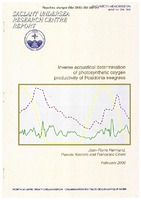| dc.description.abstract | As part of geoacoustic inversion experiments (Yellow Shark) in the Giglio basin, off the west coast of Italy, low frequency, broad-band propagation measurements were performed in the winter and spring of 1995 over a dense and extensive prairie of Posidonia seagrasses which surrounds Scoglio d'Africa, a minor island of the Tuscan Archipelago. The purpose of the measurements was to determine the applicability of model-based, geoacoustic inversion techniques developed for marine sediments to the monitoring of oxygen synthesis by Posidonia. A dualextensional acoustic projector and a 4-element vertical receiving array were positioned at 1541 m distance in an isobath (25 m water depth), dense and homogeneous part of the Posidonia prairie. The waveguide impulse response was measured during one day by 1 min repeated and alternated transmissions of 3 s chirp signals with frequency bands 0.1-0.9 kHz and 0.8-1.6 kHz. The water sound speed profiles calculated from repeated CTD measurements were slightly downward refracting and exhibited little temporal variability except for mild surface heating in the afternoon. Contemporaneous oxygen and CTD profiles as a function of daytime and season were obtained in 1997 to support the present study. In this paper acoustic, solar radiation, oxygen and CTD data are analyzed and discussed. The analysis shows strong correlation between photosynthesis and the impulse response of the acoustic waveguide. The most evident feature is an abrupt and marked change of attenuation and time dispersion characteristics at the onset of photosynthesis. Frequency- and depth-dependent rapid variations of received energy (2-5 dB) and time spread (3-10 ms) are observed. The time of occurence and rate of change of these variations are consistent with solar time and oxygen concentration measured in situ. The phenomena is attributed to bubbles of photosynthetic oxygen formed on the Posidonia leaf blades. The bubble layer creates an absorbing, dispersive, low-speed, thin parallel waveguide which modifies interaction of acoustic energy with the Posidonia "matte". It is demonstrated that, after sunrise, low-order modes begin to travel in the seagrass layer, absorbing a portion of acoustic energy from the main waveguide. A similar effect can occur in a near-surface waveguide when supersaturation (undissolved oxygen) conditions obtain. Modeling results indicate that the inverse problem of determining gas and oxygen void fractions in the seagrass layer could be solved. Parameters such as surface density and photosynthetic efficiency of Posidonia can be derived from the variations of inverted void fractions. These results may be applicable to the monitoring of the state of health of Posidonia and other seagrasses in the Mediterranean and other oceans. | |
